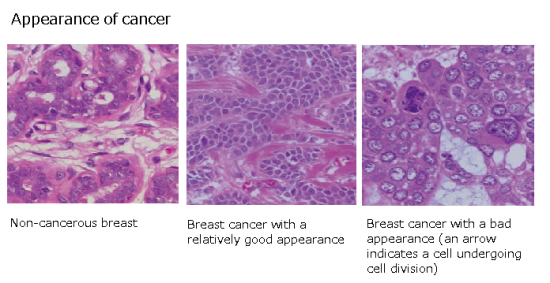Top > About Us > News Letter > Aiming for a better understanding of breast cancer before receiving treatment
Aiming for a better understanding of breast cancer before receiving treatment
We asked Dr. Takeshi Sasaki, Associate Professor in the Department of Pathology, about the “outpatient clinic of breast cancer pathology.”
We have the outpatient clinic of breast cancer pathology
I wonder if some patients who were diagnosed with cancer have concerns or questions, such as “I do not understand details of the pathological diagnosis.” or “Why is such a treatment necessary?” At the Division of Diagnostic Pathology, we have the outpatient clinic of breast cancer pathology on Monday afternoon. The targeted patients are those who were diagnosed with breast cancer in this hospital or those who have or will have treatment for breast cancer in this hospital. We aim to resolve any concerns or questions so that all of the patients are convinced about receiving their treatment. While a pathologist and a patient look at images of the patient’s cells together, the pathologist provides the patient with detailed information about the pathological diagnosis. The pathologist also answers various questions from the patient.
Relationship between cancer diagnosis and pathologists
Some people may wonder why pathologists are involved. The reason is because diagnostic pathology makes a great contribution to the diagnosis of a tumor and the decision about the therapeutic strategy. In diagnostic pathology, we observe cells under a microscope and judge the characteristics of a disease (e.g., malignant or benign tumor; or if it is cancer, the type and grade of malignancy) or the range affected by the disease. Based on these results, the therapeutic strategy for the patient is determined. In the University of Tokyo Hospital, pathologists are in charge of diagnostic pathology.
Characteristics of cancer cells vary widely
Each cancer cell has different characteristics. For example, breast cancer has two major origins, namely lobules and mammary ducts; however, the characteristics of breast cancer from these two origins are different. The best treatment is also different depending on the appearance of the cancer cells, the size of the cancer, or other factors. Pathological diagnosis of breast cancer includes information about whether cancer cells express various receptors, such as estrogen receptor (ER), progesterone receptor (PR), and human epidermal growth factor receptor 2 (HER2). This information is extremely important for determining the therapeutic strategy. For example, when the result of the ER, PR, and HER2 analysis suggests an indication of endocrine therapy but many cancer cells are observed in the lymphatic vessels, chemotherapy is required because these cells are highly likely to metastasize to the whole body. The growth speed of cancer is also related to what the cancer cells look like. Some cancers develop their size slowly and other cancers grow quickly. Microscopic observation of each type of cancer shows that cells in slow-growing cancers look similar to normal cells, whereas cells in fast-growing cancers have extremely large nuclei or undergo active cell division. We call such finding an “appearance” of cancer cells. In general, cancer with a bad “appearance” tends to progress quickly; however, it is more sensitive to chemotherapy and even disappears after chemotherapy in some cases. The outpatient clinic of breast cancer pathology uses a technique called virtual slide, by which a patient can see the “appearance” of her own cancer cells in the same way as on a microscope.
We cooperate with a patient’s attending physician
The pathologist in charge of the outpatient clinic of breast cancer pathology cooperates with a patient’s attending physician. If a patient sees her own disease at a cellular level in this clinic, she may be able to understand the disease better, which can be useful for future treatment. For example, if a patient is at a loss about which treatment to choose, she can visit us to obtain detailed information and resolve her questions. Then she can discuss her treatment with her attending physician. By this process, we believe that the patient is more convinced about the choice of treatment.

